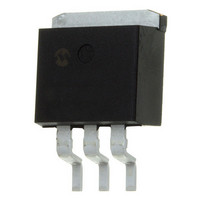MCP1825S-1202E/EB Microchip Technology, MCP1825S-1202E/EB Datasheet - Page 21

MCP1825S-1202E/EB
Manufacturer Part Number
MCP1825S-1202E/EB
Description
500 MA CMOS LDO, Vout=1.2V, Extended Temp Range 3 DDPAK TUBE
Manufacturer
Microchip Technology
Datasheet
1.MCP1825T-ADJEDC.pdf
(38 pages)
Specifications of MCP1825S-1202E/EB
Regulator Topology
Positive Fixed
Voltage - Output
1.2V
Voltage - Input
2.1 ~ 6 V
Voltage - Dropout (typical)
0.21V @ 500mA
Number Of Regulators
1
Current - Output
500mA (Min)
Operating Temperature
-40°C ~ 125°C
Mounting Type
Surface Mount
Package / Case
TO-263-3, D²Pak (3 leads + Tab), TO-263AA
Number Of Outputs
1
Polarity
Positive
Input Voltage Max
6 V
Output Voltage
1.2 V
Output Type
Fixed
Dropout Voltage (max)
0.35 V at 500 mA
Output Current
500 mA
Line Regulation
0.05 % / V
Load Regulation
0.5 %
Voltage Regulation Accuracy
0.5 %
Maximum Operating Temperature
+ 125 C
Mounting Style
SMD/SMT
Minimum Operating Temperature
- 40 C
Lead Free Status / RoHS Status
Lead free / RoHS Compliant
Current - Limit (min)
-
Lead Free Status / Rohs Status
Lead free / RoHS Compliant
The maximum power dissipation capability for a
package can be calculated given the junction-to-
ambient thermal resistance and the maximum ambient
temperature for the application. Equation 5-4 can be
used to determine the package maximum internal
power dissipation.
EQUATION 5-4:
EQUATION 5-5:
EQUATION 5-6:
© 2008 Microchip Technology Inc.
P
P
T
T
T
T
D(MAX)
D(MAX)
A(MAX)
J(RISE)
J(RISE)
J(MAX)
Rθ
Rθ
T
T
JA
JA
A
J
P
D MAX
= Maximum device power dissipation
= maximum continuous junction
= maximum ambient temperature
= Thermal resistance from junction-to-
= Rise in device junction temperature
= Maximum device power dissipation
= Thermal resistance from junction-to-
= Junction temperature
= Rise in device junction temperature
= Ambient temperature
T
(
J RISE
(
over the ambient temperature
ambient
over the ambient temperature
temperature
ambient
T
)
J
=
)
=
=
(
---------------------------------------------------
T
T
P
J RISE
J MAX
(
(
D MAX
(
Rθ
)
)
+
–
)
JA
×
T
T
A
A MAX
Rθ
(
JA
)
)
MCP1825/MCP1825S
5.3
Internal power dissipation, junction temperature rise,
junction temperature and maximum power dissipation
is calculated in the following example. The power
dissipation as a result of ground current is small
enough to be neglected.
5.3.1
5.3.1.1
The internal junction temperature rise is a function of
internal power dissipation and the thermal resistance
from junction-to-ambient for the application. The
thermal resistance from junction-to-ambient (Rθ
derived from EIA/JEDEC standards for measuring
thermal resistance. The EIA/JEDEC specification is
JESD51. The standard describes the test method and
board specifications for measuring the thermal
resistance from junction to ambient. The actual thermal
resistance for a particular application can vary
depending on many factors such as copper area and
thickness. Refer to AN792, “A Method to Determine
How Much Power a SOT23 Can Dissipate in an
Application” (DS00792), for more information regarding
this subject.
Package
Input Voltage
LDO Output Voltage and Current
Maximum Ambient Temperature
Internal Power Dissipation
Package Type = TO-220-5
P
T
LDO(MAX)
T
T
J(RISE)
T
JRISE
JRISE
Typical Application
A(MAX)
V
P
P
I
OUT
OUT
POWER DISSIPATION EXAMPLE
LDO
LDO
V
IN
Device Junction Temperature Rise
= P
= 0.514 W x 29.3° C/W
= 15.06°C
= 3.3V ± 5%
= 2.5V
= 500 mA
= 60°C
= (V
= ((3.3V x 1.05) – (2.5V x 0.975))
= 0.514 Watts
TOTAL
x 500 mA
IN(MAX)
x Rθ
– V
JA
OUT(MIN)
DS22056B-page 21
) x I
OUT(MAX)
JA
) is













